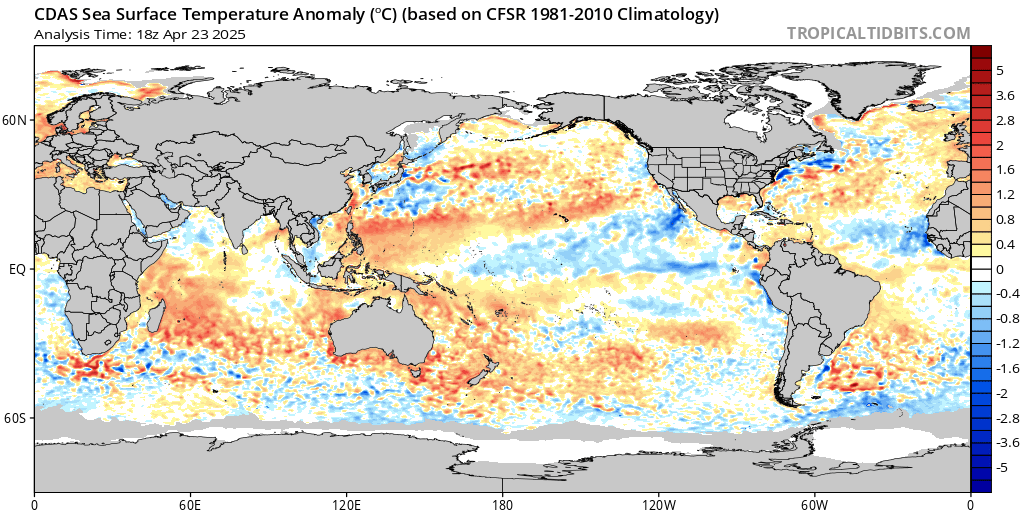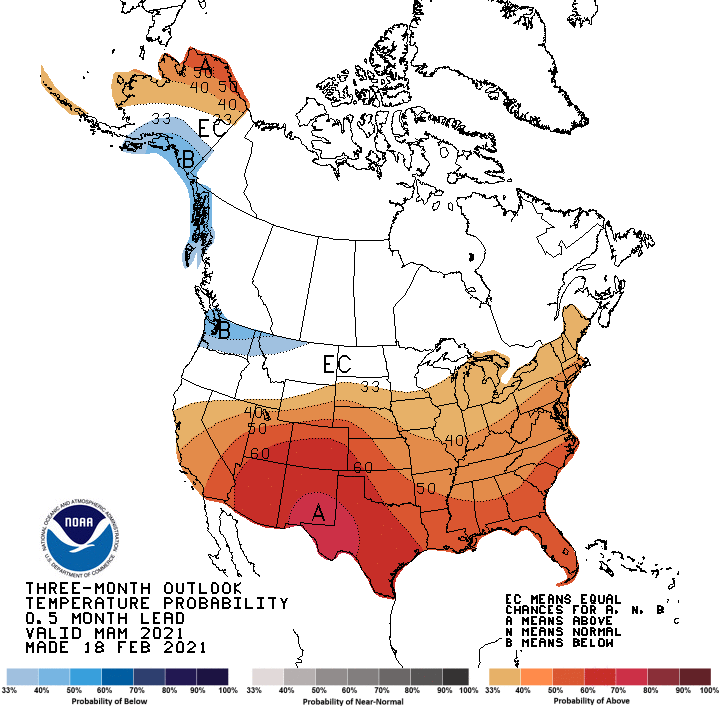Dear Diary. The main purpose of this ongoing blog will be to track global extreme or record temperatures related to climate change. Any reports I see of ETs will be listed below the main topic of the day. I’ll refer to extreme or record temperatures as ETs (not extraterrestrials).😉
Main Topic: U.S. Average Temperature Spring Forecast
Dear Diary. Welcome to boreal or meteorological spring tomorrow if you live in the United States, or the three months that are March, April and May. It’s time for me to make another attempt at a forecast for average seasonal temperatures in the U.S. This forecast will be very broad and not specific for any one state comprising the continental United States (or lower 48 states).
So how will boreal Spring 2021 stack up compared to long term temperature averages across the United States? Will we continue to see the climate crisis signature of warmer than average conditions? Let’s try to make a forecast as usual at the start of a new season.
So how did the forecast work out for Winter 2020/21? Here is a link to the post for that forecast:
By March 7th the National Center for Environmental Information will finish their assessment for Winter 2020/21, so our verification is not complete as of March 1st. Let’s do fill in ranking numbers with 1 being the coldest and 126 warmest for a verification for December and January, which have already been assessed:

I’ll complete the Winter 2020/21 verification for this post around March 7th when NCEI processes their numbers.

And here is that verification: The ranking for Winter 2020/2021 verified at 98, or 98th coolest since 1895. My forecast was for a ranking of 100 + or -10 was about spot on.
Here are my two cents for a broad, rough forecast for the U.S. for Spring 2021, which I guarantee to be warmer than this past winter, of course, as the amount of daylight increases across the Northern Hemisphere. First, I like to look at water temperature anomalies surrounding North America just before the start of a season to get a sense of how much potential heat can be added to the atmosphere across the continent. Here is what we see:

This time around we have cooler than average temperatures across the West Coast linking up with cool La Nina waters across the equitorial Pacific. The moderate La Nina should persist during this coming spring, Above average temperature surface waters lie off the East Coast and in the Gulf. These features lead me to forecast a tendency towards cold troughs moving from the Pacific into the West interacting with warm upper ridges in the East. Cold and warm temperatures would tend to cancel each other out as air masses collide in the central U.S. leading to very storm conditions…so watch out for above average tornado outbreaks. Overall, we see a neutral factor here.
Second, I like to look at the strength of the Hudson Bay low or polar vortex at the start of any season:

On the above Pivotal Weather chart we see a typical La Nina pattern with a fairly robust vortex milling around Hudson Bay and a cold trough moving eastward through the Rockies. Elsewhere we see warm (red) anomalies. Given a continuation of a positive North Atlantic Oscillation, cold air masses should continue to get injected into the U.S. from time to time, so this factor is neutral, as well. If there was a tendency towards a negative NAO, which we had most of February, this factor would be cold.
Here is the National Weather Service forecast for Spring 2021:
https://www.cpc.ncep.noaa.gov/products/predictions/long_range/lead01/off01_temp.gif

I think that the NWS forecast will verify, except it might be too warm in the Southwest given cooler than average water temperatures off of California.
Overall, Spring 2021 will probably verify above average looking at trends from the rest of the planet.
Last, we can get another clue looking at prior National Center for Environmental Information ranking and temperature record count data. For this I like to drag out that “Record Scoreboard” (updated through 2/26/2021):

We were having a milder than average winter until the historic cold outbreak that devastated Texas in February. That event will probably bring Winter 2020/21 temperature average rankings close to average, but still above the average ranking number of 63. Notice that since late 2019 we are seeing a cold month about once every four months, so the next three may be warm. This trend would lead me to predict a warm spring.
Other factors like meteorological models are forecasting cooler than average conditions only in the West and northern tier of states as we head into March.
I expect a temperature relative to average neutral trend through May. All three spring months should be above average, but I doubt that any will approach a top ten ranking. I don’t expect any of the three months to see a colder than average ranking below 63. (Here are avg. rankings per year for the lower 48 states since 1895):
https://www.ncdc.noaa.gov/cag/national/rankings/110/tavg/202004
Not all seasons in the near future will see above average temperatures, but seasonal forecasters are beginning to ”chuck it,” discounting colder than average scenarios due to carbon pollution.
Again, here are all seasons ranked for the last decade:

Here is my bottom line forecast for Spring 2021:
“I think that this spring will be ranked slightly cooler than that of the 2020. Carbon pollution is definitely making below average seasons more rare. I’m going to guess that the Spring 2020 ranking will be around 90 + or – 10, with near average confidence given all of the factors on this post.”
Notice that the past six springs had a ranking at or above 67, and that of 2013 was the coldest relative to averages for the last decade. The big El Nino of 2015/16 really spiked global temperatures as well as those for the U.S. Will increased global heat once again be a catalyst, helping to produce another “heat spell” or two during spring for the United States, causing my relatively cool forecast of a ranking near 90 to bust, or will my forecast be too warm? We will see.
As of 2021 the top ranking for any month or season would be 126 since climatological rankings for the United States started in the year 1895. I think that this spring will be ranked at least as high as 90. Carbon pollution is definitely making below average seasons more rare. As stated, I’m going to guess that the spring of 2020/21 ranking will be around 90 + or – 10, but with average confidence given all of the factors in this post.
We will see how this forecast pans out around June 7th, 2021.
Here is an “ET” reported from Saturday:
Here is more climate and weather news from Sunday:
(As usual, this will be a fluid post in which more information gets added during the day as it crosses my radar, crediting all who have put it on-line. Items will be archived on this site for posterity. In most instances click on the pictures of each tweet to see each article. The most noteworthy items will be listed first.)
Now here are some of today’s articles and notes on the horrid COVID-19 pandemic:
(If you like these posts and my work please contribute via the PayPal widget, which has recently been added to this site. Thanks in advance for any support.)
Guy Walton “The Climate Guy”